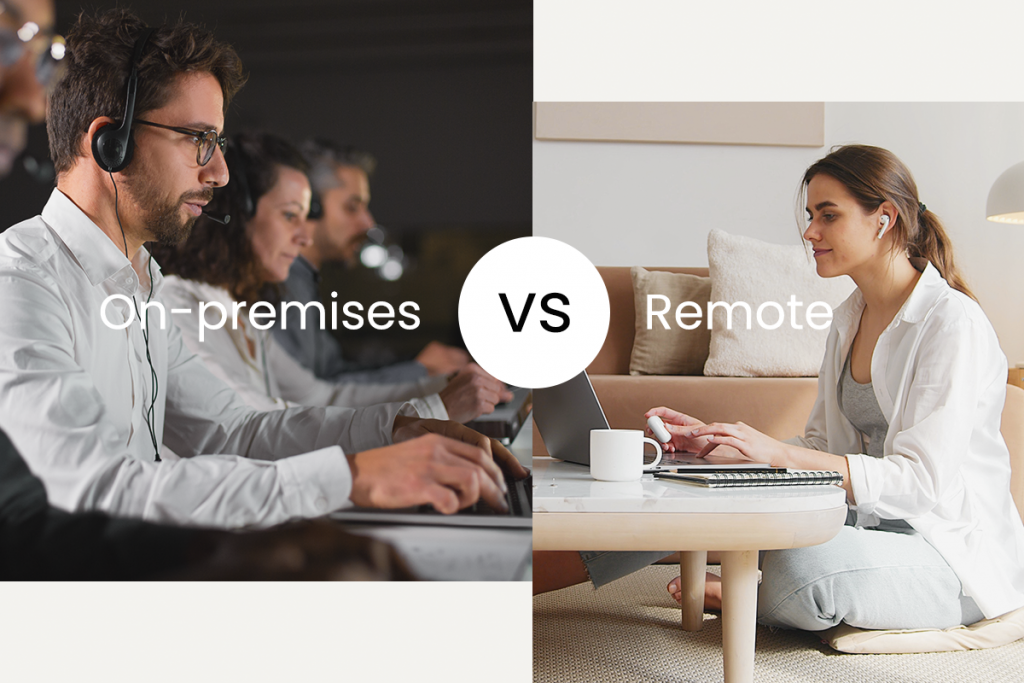When a company is growing concerning CX, the number of customers tends to grow as well. To keep up with the growing demands of the customers, which is why companies are under the pressure to scale up the CX operations when they grow rapidly.
An on-premises contact centre is a conventional setup for offices. This traditional arrangement involves desk phones, physical equipment, and servers, and all this equipment is stored at the worksite. Although the number of businesses using on-premises contact centres is reducing, some businesses are still using this as an in-house facility. When it comes to a cloud-based contact centre, there is no physical equipment required as the server is online. Agents can communicate and interact with customers using any internet-powered device like cell phones, laptops, or desktops.
Let’s explore four aspects in which we explore how on-premise is different from remote.
#1 Agent Productivity
On-premises agents will have to manually manage various aspects on their own which will eventually lead to distraction and additional time loss. Time loss stems from workplace distractions and such.
With remote agents, agent productivity increases by 20-25 percent primarily because the agent is satisfied working from home or a similar zone of comfort. In addition to that remote agents get to work with flexible timings and get to choose the type of projects they wish to work on. These agents don’t have to worry about chatting up with colleagues or getting distracted by other calls that are parallelly happening in the workspace.
#2 Reliability and downtime
Businesses cannot afford to have ‘downtime’. When an internal call centre is bugged or glitchy, the hands of on-premises agents are tied because your server room may be overheated on a hot day or the wire of a server came loose, but either way, customers are still calling but there is no way their requirements can be met due to the technical issue at hand.
Cloud contact centres largely reduce the risk of downtime. At VOIZ, we’ve got a 99.9% record that guarantees uninterrupted uptime. There are instances where remote agents working from home experience power cuts, technical glitches, etc. However, if it is handled right with proper remote and dialler technology that even when call volumes and demands peak during ‘down-time’ from the agent side, a domestic level power backup can be a workable solution. But when we compare this to the heating and lighting costs faced by on-premises, this alternative technology solution always ends up winning with its cost-saving benefits.
.#3 Flexibility
Flexibility is out of the picture for on-premises agents who have to take calls at the office from wired devices. This means that it requires them to sit around those systems all day to ensure not missing a call, even during the time when the volumes are low. With on-premises agents’ work culture being the punch-in, punch-out type; it tends to restrict the agents and creates a feeling of monotony and rigidity with their job.
For remote agents, as the name suggests, they can work from anywhere and take business calls from their devices and they get paid for the hours they work since the work culture here is ‘pay per call’. This enhances the motivation of remote agents as the job offers the flexibility of work hours and freedom of project type. The key element here is that with all these incentives in place, it makes it easier for agents to stay self-motivated and meet their KPIs. All they need is an internet connection and a phone or a laptop. At VOIZ, we constantly emphasize the aspect of flexibility, which allows agents from anywhere to get employed, gain exposure and be financially independent.
#4 Integrations
Integration with an on-premise call centre with other services is higher mainly due to licensing, hardware dependency, and installation. Agents will have to make themselves accustomed to top technological integrations and implementation to make the agent-customer experience easier and smoother. With cloud-based technology, since everything is virtual, it is based on the SAAS model and pay-as-you-go model. This model works on-demand and offers scalability.

